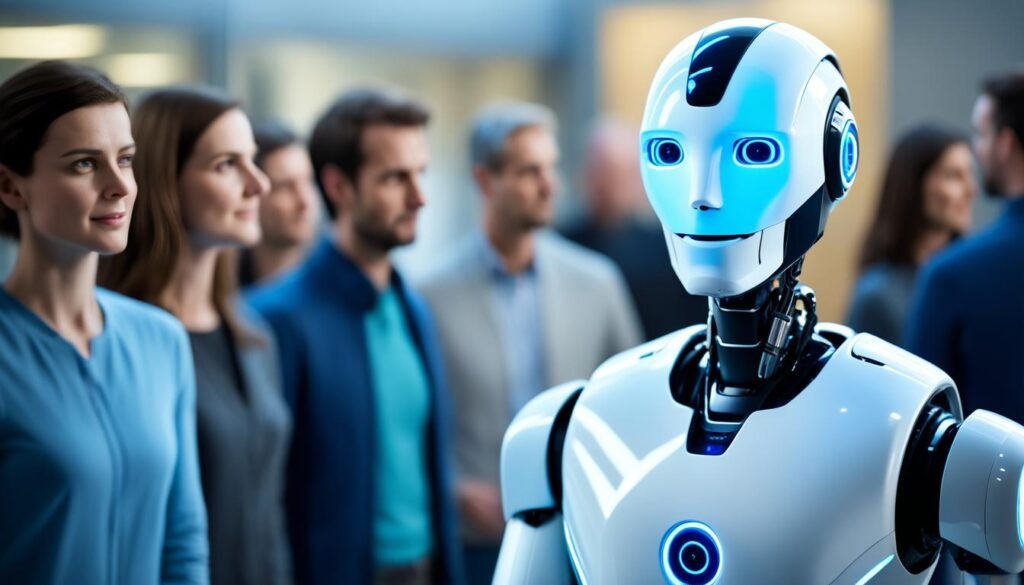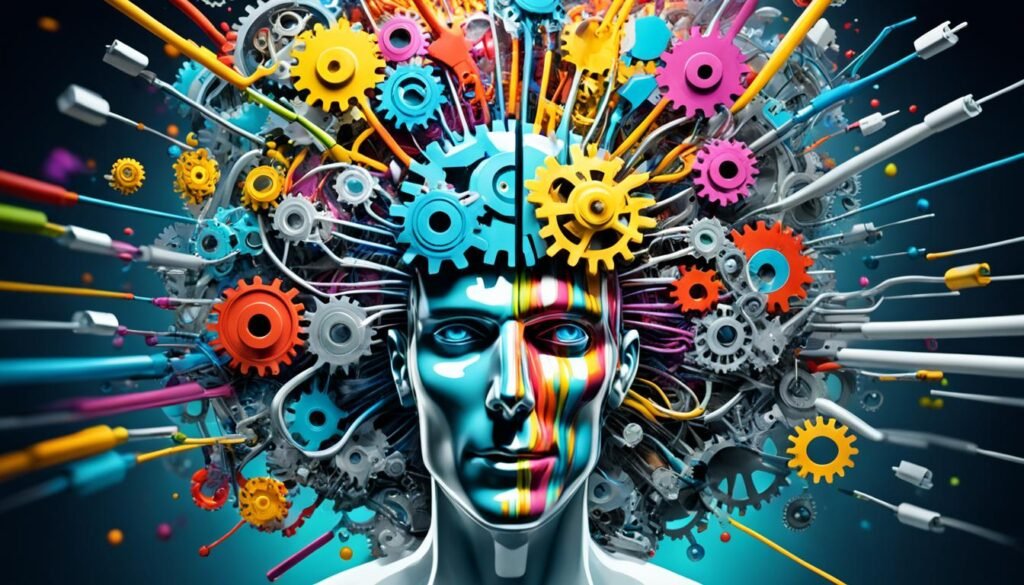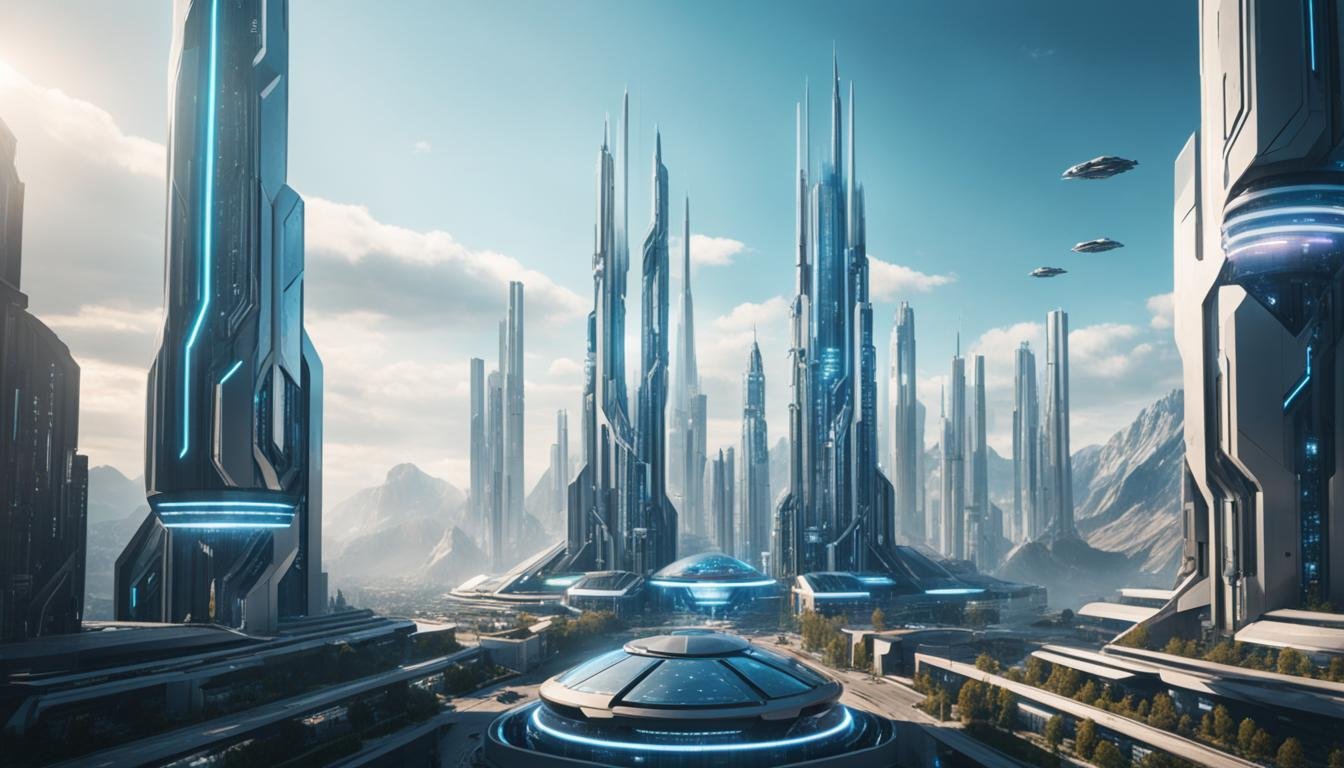About 85 million jobs might be taken over by machines with AI by 2025. But, AI can’t fully replace human smarts. It misses out on the physical touch, emotional smarts, creativity, and soft skills that humans have. It’s key to know what AI can and can’t do as you use it in your work.
Only humans can design, run, and keep AI systems going. Jobs like plumber, electrician, police officer, bricklayer, and construction worker are hard for AI to take over because they need manual work. Also, skills like teamwork, paying attention to details, and creative thinking are vital for doing well in any job. These skills can’t be learned by AI.
Key Takeaways
- AI lacks the physical form, emotional intelligence, creativity, and soft skills that make human intelligence irreplaceable.
- While AI can automate many tasks, it requires human design, operation, and maintenance within organizations.
- Certain jobs, such as blue-collar roles, are less susceptible to AI automation due to their reliance on manual labor.
- Soft skills, like teamwork and effective communication, are crucial for professional success and cannot be developed by AI.
- As you incorporate AI, it’s essential to manage expectations and understand the limitations of this technology.
When looking into AI for your business, remember it’s not a replacement for human smarts. Think of AI as a tool that can help and improve your team. By knowing what AI can and can’t do, you can make a work environment that uses the best of human and AI skills.
Learn more about the roleof AI in the.
AI Lacks Physical Form
AI has made huge strides, but it still faces physical challenges. It doesn’t have a body like humans do. This means it can’t do tasks that need fine hand skills, good eye-hand coordination, or quick thinking in new situations.
Limitations of AI in Performing Physical Tasks
AI can’t do many physical jobs, except for some robots. It struggles with tasks like picking up objects, moving through crowded areas, or changing direction fast. Even with AI’s help in planning and managing warehouses, people are still needed to do the actual work.
AI’s Need for Human Assistance in Physical Environments
AI can’t fully work in the real world because it has no body. It depends on humans for tasks that need physical touch, flexibility, and solving problems. Jobs like making things, building, or healthcare still need people to work with AI to get things done.

“The future of work will involve a partnership between humans and AI, where AI augments and enhances human capabilities, rather than replacing them entirely.”
As AI gets better, we must remember its limits and the need for humans in tasks that need fine skills. The partnership between humans and AI is key to using their strengths together. This makes work more balanced and effective.
Emotional Intelligence: The Missing Ingredient
In the workplace, emotional intelligence (EQ) is key. It helps workers predict reactions, understand colleagues, and act right. But, AI systems don’t have this EQ yet. They’re great at simple tasks but can’t feel emotions like humans do. This is important for jobs like managing teams, teaching, and counseling.
The Importance of Emotional Quotient (EQ) in the Workplace
Emotional intelligence means knowing, understanding, managing, and reasoning with emotions. People with high EQ handle relationships better, stay calm under stress, and make choices that think about others’ feelings. AI lacks emotional intelligence and can’t feel or understand emotions like humans do.
- Studies show that those with more emotional intelligence do better in their jobs. They work well with others, lead, and solve problems.
- EQ is key in jobs that involve a lot of talking with others. Being able to feel and talk about feelings is very important.
- AI is great at analyzing data and automating tasks, but it can’t match the emotional and social parts of work that employers value.
AI’s Inability to Understand and Express Emotions
Even with progress in natural language processing and machine learning, AI can’t grasp the complex nature of human feelings. Emotional intelligence combines thinking and feeling, which is hard for AI to handle.
| Emotional Intelligence Attribute | Human Capability | AI Capability |
|---|---|---|
| Empathy | Humans can feel and share others’ feelings. | AI often misses the mark in understanding and reacting to human emotions. |
| Emotional Expression | Humans show feelings through words and actions. | AI chatbots and virtual assistants can’t express emotions in a real way. |
| Emotional Regulation | Humans control their feelings and react to others’. | AI systems can’t manage emotions like humans do. |
The area of emotional intelligence AI is growing fast. But, AI still can’t match the emotional smarts and gut feelings that humans have at work.

Creativity: A Human Forte
AI has made big steps in helping with creative tasks, but human creativity is still unmatched. AI uses set data, which limits its creative potential. Humans, on the other hand, have endless creativity and can adapt easily.
Studies show how AI and human creativity work well together. For example, Google’s AI platform, NotebookLM, used 594,379 words from 719 sources to help with creativity. ChatGPT helped make children’s storybooks, but humans had to add the final touches.
AI as a Creative Tool, Not a Replacement
AI has made tasks like note-taking in Notion easier. But it’s best used to help, not replace, human creativity. ChatGPT can summarize books fast, but it needs human editing to be perfect.
AI and creativity might seem odd together, but AI as a creative tool can really help. It automates simple tasks, letting people focus on the creative stuff.
“Creativity is not just about the final product; it’s about the journey, the exploration, and the human connection that makes it truly exceptional.”
The future of work will keep changing, and human creativity will always be key. Using AI to help, not replace, us lets us reach our creative best.

Data Dependency: AI’s Achilles’ Heel
AI’s smarts rely a lot on the data it gets. It uses this data to make answers, but it can only go as far as the data takes it. If the data is bad, AI’s answers will be too. This makes AI’s use of data a big problem, as it can’t understand or adapt like humans do.
Poor data can cost businesses 15% to 25% of their income. Also, up to 85% of AI projects fail because of biased data. This shows AI isn’t a magic solution and needs careful human checking to work right.
Moreover, 62% of companies say human smarts are key to making AI work. AI can’t match human creativity or emotional intelligence, which are key for many tasks. Humans are needed to run AI, keep it working, and provide the good data it needs.
| Statistic | Insight |
|---|---|
| 53% of business leaders cite lack of skilled staff as a major challenge in integrating AI into marketing. | The successful integration of AI requires skilled human professionals to oversee and maintain these systems. |
| 48% of companies find integrating AI with existing processes difficult. | AI systems often struggle to seamlessly integrate with existing workflows and processes, highlighting the need for human adaptation and intervention. |
| 86% of consumers are wary of how companies use their data. | The public’s growing concern over data privacy and AI’s handling of sensitive information underscores the importance of human oversight and ethical considerations. |
AI has grown a lot lately, but it still needs good data to work well. As AI gets better, we’ll see that human smarts and watchful eyes are key to using these tools right.
“The real power of AI will be realized when it is combined with human intelligence and experience.”
Soft Skills: The Human Touch
As technology gets better, the need for soft skills in the workplace grows. Skills like respectfulness, negotiation, confidence, friendliness, adaptability, team-building, innovation, and creativity are key for teamwork and working together. These skills come from human training and are vital for any organization’s success.
AI can’t develop or use soft skills, which are vital for many jobs. AI is great at technical tasks but struggles with people skills and understanding human behavior. So, humans will always be needed to add the “human touch” to work, even with more AI in industries.
The Significance of Soft Skills in Teamwork and Collaboration
Teamwork and collaboration are crucial for any organization’s success. Soft skills like communication, empathy, and teamwork are essential. They help build trust, solve problems, and create a united team spirit.
- Studies show that 75% of employees find that collaboration is more effective when working with other humans rather than relying solely on AI tools.
- Research indicates that 90% of individuals see interpersonal problem-solving skills as essential at work, an area where AI tools fall short.
AI’s Lack of Soft Skills for Interpersonal Interactions
AI is great at analyzing data and automating tasks but struggles with understanding people. It can’t read human behavior or respond with empathy. This makes it hard for AI to work well with humans and help the organization succeed.
“Soft skills, such as understanding, empathy, negotiation, and emotional intelligence, are deemed essential for effective team dynamics in the workplace.”
As companies use more AI, it’s important to value human soft skills. By focusing on these skills, companies can balance technology with the human touch. This leads to more innovation, teamwork, and success.

Fact-Checking: The Need for Human Oversight
In today’s world, AI-generated content often spreads false information. AI can make text sound real but doesn’t always know if it’s true. This is why we need human fact-checking.
The Prevalence of Misinformation in AI-Generated Content
AI uses big datasets to learn, but these can have mistakes or biases. So, AI content might spread wrong info or tell lies. Without humans to understand the context, AI can make mistakes, ignore logic, and miss deeper meanings.
The Importance of Human Verification and Adjustment
AI can help check facts, but it’s not enough to rely only on it. AI systems can overlook important details or struggle with complex situations. Humans are key to making sure info is right and fair.
Skilled people must check AI’s work, fix any errors, and make sure the info is correct and fair. This way, we keep the info we share with the public trustworthy.
In summary, the rise of ai misinformation shows we still need human fact-checking of ai and importance of human oversight of ai. By using both human smarts and AI power, we can make content that’s reliable and helps people.
why can’t ai replace human intelligence
Automation’s Reliance on Human Intervention
AI and automation follow strict rules but still need humans to work well. Humans train, maintain, and fix these systems when problems come up. Without human help, AI automation can fail, showing how crucial humans are in tech.
The Human Capacity for Improvisation and Adaptation
Humans can improvise and adapt in ways AI can’t. This makes us better than automated systems in solving complex problems. Our ability to think on our feet is something AI doesn’t have yet.
AI has grown a lot, but it can’t match human intelligence yet. The human role in automation and our ability to improvise are what set us apart from AI. This means we’ll always be needed in the changing world of tech and innovation.
“There is no model today that doesn’t suffer from some degree of hallucination,” – Daniela Amodei, AI researcher
Working together with AI, humans are key to making sure AI creates good content. We need to guide AI with the right prompts and feedback. AI can make unfair decisions if it’s biased, like in loan or rental applications, showing why we must watch over it.
AI is always changing and could change businesses a lot. But, human intelligence is still key for success. As AI gets better, our unique skills will keep being important. They will work alongside AI, not replace it.
Embracing AI as a Complement, Not a Replacement
The rapid growth of artificial intelligence (AI) shows us it’s key to see AI as a partner, not a replacement for human smarts. By combining human and AI, businesses can boost their skills and stay ahead.
AI can automate simple tasks, offer deep insights, and let people focus on complex, creative work. Research shows that companies using human and machine together see the biggest gains.
The Synergy Between Human and Artificial Intelligence
Humans are needed to train AI, explain its results, and use it responsibly. AI, in turn, can boost our thinking, creativity, and physical abilities. AI’s big role is to support and improve human skills, not take over.
AI’s Role in Augmenting, Not Replacing, Human Capabilities
AI is getting better at things like diagnosing health issues, translating languages, and helping with customer service. But it’s key to remember it’s meant to work with humans, not replace them. Using AI to rethink business can make things faster, smarter, and more tailored to what people want.
By working together, humans and AI can open up new doors and spark innovation. This way, we tackle worries about job loss and let people and AI work side by side. They use their best traits to achieve more together.
Conclusion
AI and automation have made big strides and help with many tasks. But, they can’t take the place of human smarts. Humans bring unique skills like physical abilities, emotional smarts, creativity, flexibility, and soft skills to the job.
These skills make human workers essential in today’s world. As companies add AI and automation, they should use both human and artificial intelligence together. This way, they don’t see them as rivals.
By doing this, businesses can make the most of their teams and keep up with new tech. Those that quickly swap humans for AI without thinking it through might struggle with profits and worker morale. But, those that carefully add AI can see huge gains in efficiency and new solutions by combining AI with human skills.
The main point is clear: humans can’t be replaced by AI. Humans can adapt, innovate, and add emotional depth to their work in ways AI can’t match. By valuing both human and artificial intelligence, you can set your company up for success in the fast-paced tech world.
FAQ
Why can’t AI replace human intelligence?
AI can’t replace human intelligence because it lacks physical form and emotional smarts. It can automate tasks and give insights. But, it can’t match the unique qualities of human thinking, like physical skills, emotional smarts, creativity, adaptability, and social skills.
How does AI’s lack of physical form limit its capabilities?
AI has no physical form, which means it can’t do tasks that need hand-eye coordination or quick movements. It can help with some physical tasks but still needs humans for planning and doing these tasks.
Why is emotional intelligence important in the workplace, and how does AI fall short in this area?
Emotional intelligence (EQ) is key in business because it helps predict reactions and act right. But AI can’t feel emotions or understand them. Jobs like team leading, teaching, and counseling need EQ, which AI can’t offer.
How does human creativity differ from AI-generated creativity?
Human creativity is unique and can’t be fully replicated by AI. AI uses set data and can’t go beyond it. Humans have endless creative potential and get inspiration from many experiences. AI can help in creative fields but can’t replace human creativity and flexibility.
What are the limitations of AI in terms of data dependency?
AI’s smarts depend on the data it gets. It uses this data to give answers but is limited by it. If the data is wrong, AI’s answers will be too. So, humans are needed to run and improve AI, and to give it the right data.
Why are soft skills important, and how do they differ between humans and AI?
Soft skills like being respectful, negotiating well, and being adaptable are important at work. These skills come from human training and are key for teamwork. AI can’t develop or use these skills, which are vital for many jobs.
How does human oversight and intervention remain necessary for AI-generated content?
AI can make mistakes because it just gives answers based on its training data. Even AI checks can’t always catch errors. So, humans are needed to check AI’s work and fix any mistakes to make sure the info is right.
Why do AI and automation still require human intervention and oversight?
AI and automation need humans to work right. Humans train, fix, and improve these systems when problems happen. Humans can also improvise and adapt, something AI can’t do yet.
How should organizations approach the integration of AI and human intelligence?
Companies should see AI as a tool to help human intelligence, not replace it. Using both AI and human smarts together can make a business stronger and more competitive. AI can automate simple tasks, give insights, and let humans focus on complex, creative work.
